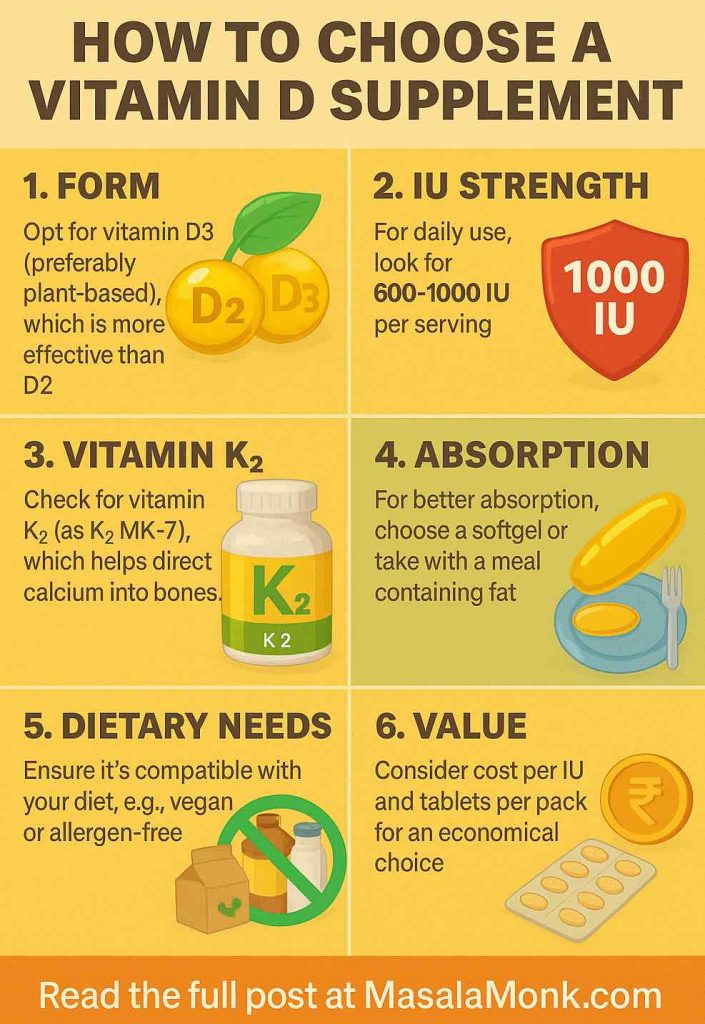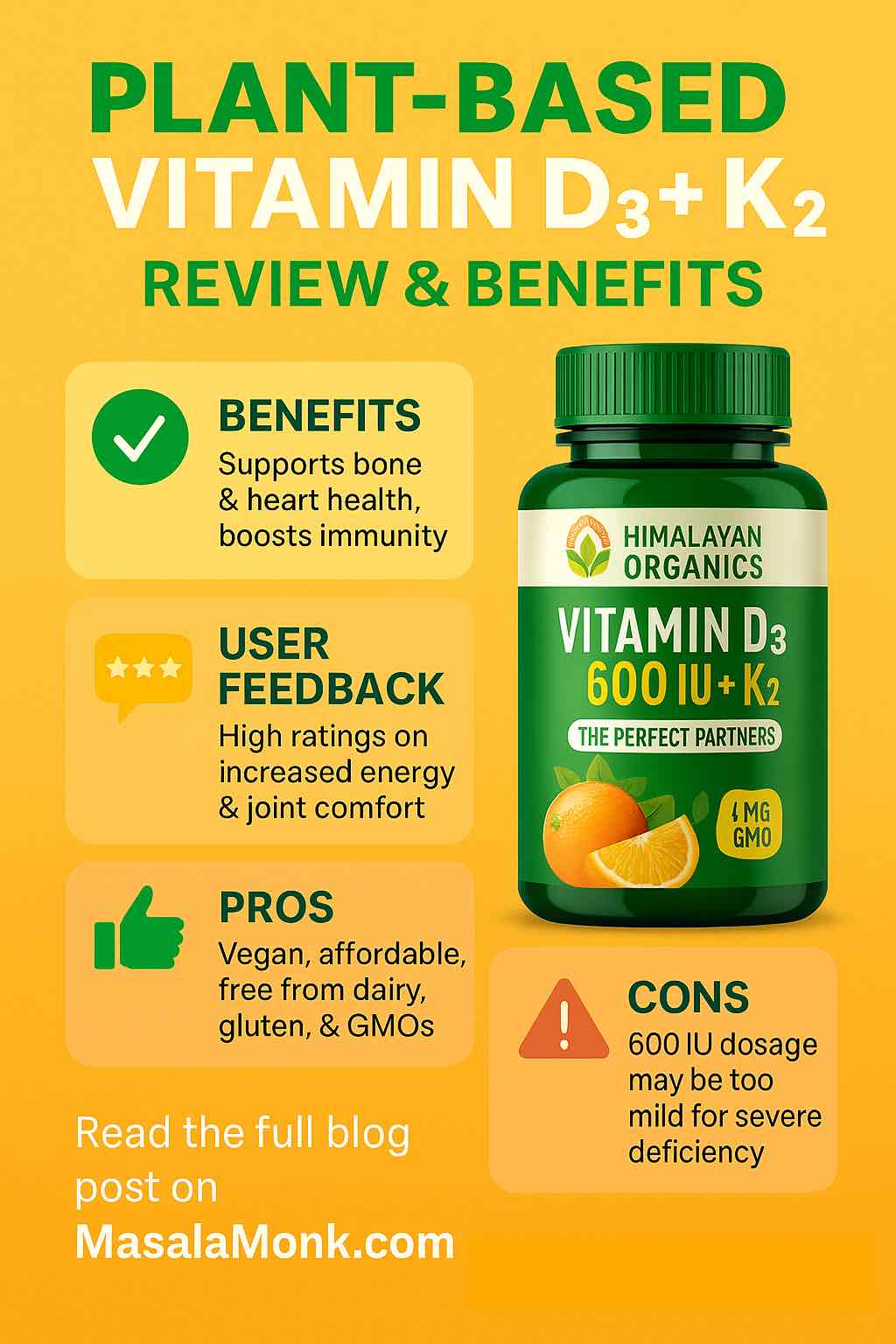
When it comes to Vitamin D supplements in India, most products either provide Vitamin D₃ alone or offer synthetic alternatives that don’t absorb well. Pure Nutrition Natural Treasures Vitamin D₃ + K₂ (MK-7) stands out by combining plant-based Vitamin D₃ with the often-overlooked Vitamin K₂ (MK-7). This pairing ensures that calcium is guided to the right places—**bones and teeth—**instead of causing unwanted deposits in arteries.
This Product features in our Top-Rated Vitamin D Supplements Available on Amazon India
Why This Formula Stands Out
Each serving of Pure Nutrition Vitamin D₃ + K₂ delivers:
- 600 IU of plant-based Vitamin D₃, sourced from lichen, making it suitable for vegetarians.
- Vitamin K₂ (MK-7), which plays a crucial role in directing calcium to bones while preventing arterial calcification.
This combination aligns with what research highlights in the connection between calcium, Vitamin K₂, and vascular calcification. The dual-action formula makes it more effective than standalone Vitamin D tablets.
Each bottle contains 60 tablets, offering a 2-month supply at an affordable price (typically ₹500–600 on Amazon).

Real Feedback from Amazon India
Reviews on Amazon India show a consistent trend:
- ⭐⭐⭐⭐⭐ “Totally good” — simple but satisfied experience.
- ⭐⭐⭐⭐ “The combination seems to be good to overcome bone and teeth deficiency.”
- ⭐⭐⭐⭐⭐ “Very good and effective, completes my requirement.”
- ⭐⭐⭐⭐ “Great for bones.”
Some reviews also flagged the presence of talc as an inactive ingredient, which may be a concern for consumers who prefer absolutely clean-label supplements.
Also Read: Best Fish Oil Supplements on Amazon India
Pros & Cons
Pros:
✅ Vegetarian, clean, non-gelatin formula.
✅ Combines D₃ and K₂ for improved calcium absorption and cardiovascular safety.
✅ Affordable and widely available on Amazon.
✅ Well-suited for mild deficiency and long-term maintenance.
Cons:
❌ At 600 IU, dosage may be too low for those with severe deficiency.
❌ Contains additives such as talc, which may concern purists.
❌ Transparency on third-party testing could be improved.
Also consider OSOAA Vitamin D₃ + K₂ (MK-7) + B₁₂ Review or Tata 1mg Vitamin D₃ + K₂ (MK-7) Review and Vlado’s Himalayan Organics Vitamin D₃ + K₂ (MK-7) Review
Who Should Use Pure Nutrition D₃ + K₂?
- Vegetarians seeking a non-animal source of Vitamin D₃.
- Adults looking for a maintenance supplement after correcting deficiency.
- Anyone concerned about bone health, joint strength, and cardiovascular safety.
- Individuals who already ensure adequate calcium intake through diet or supplements.
For those experiencing significant deficiency, it’s important to first read our guide on 14 Signs of Vitamin D Deficiency and consult a doctor about higher-dose corrective options before shifting to a maintenance supplement like this.
You must read: Food for Vitamin D
Best Way to Take
- One tablet daily, ideally with a meal that includes healthy fats for optimal absorption.
- Pair with calcium-rich foods or supplements, but ensure balance with K₂—why this matters is covered in detail in our Calcium & Vitamin K₂ guide.
- Complement with natural sources such as mushrooms, dairy, and seeds. Explore our dedicated post on Food for Vitamin D.
Final Verdict
Pure Nutrition Natural Treasures Vitamin D₃ + K₂ (MK-7) is a well-rounded, vegetarian-friendly supplement that delivers both effectiveness and affordability. While not the strongest dosage available, it is ideal for long-term daily use to maintain healthy Vitamin D levels and ensure calcium is utilized effectively in the body.
It is especially beneficial for vegetarians, those with mild deficiencies, and individuals focused on both bone strength and heart health.
👉 Check today’s price on Amazon: Pure Nutrition Vitamin D₃ + K₂ (MK-7)
Related MasalaMonk Reads
- 14 Signs of Vitamin D Deficiency
- Top-Rated Vitamin D Supplements Available on Amazon India
- Food for Vitamin D
- Connection Between Calcium, Vitamin K₂, and Vascular Calcification
- Best Fish Oil Supplements in India
FAQs — Pure Nutrition Vitamin D₃ + K₂ (MK-7)
1. What makes Pure Nutrition Natural Treasures Vitamin D₃ + K₂ (MK-7) different from regular Vitamin D supplements?
Unlike standalone Vitamin D tablets, this supplement pairs plant-based Vitamin D₃ with Vitamin K₂ (MK-7). This ensures calcium is deposited into bones instead of arteries, reducing the risk of vascular calcification. Learn more in our deep dive on the connection between calcium, Vitamin K₂, and vascular health.
2. Is Pure Nutrition Vitamin D₃ + K₂ (MK-7) vegetarian?
Yes, the Vitamin D₃ here is sourced from lichen, making it vegetarian-friendly. This makes it a safer option for those avoiding animal-derived Vitamin D supplements.
3. How much Vitamin D does each tablet provide?
Each tablet contains 600 IU of Vitamin D₃, which is good for maintenance. If you suspect severe deficiency, check our guide on 14 Signs of Vitamin D Deficiency before deciding if this dosage is enough.
4. Does this supplement help with bone strength?
Yes, the combination of Vitamin D₃ and K₂ enhances calcium absorption and directs it toward bones and teeth. This makes it effective for maintaining bone strength and preventing long-term bone loss.
5. Can Pure Nutrition Vitamin D₃ + K₂ prevent arterial calcification?
It can help. Vitamin K₂ (MK-7) is specifically included to reduce the risk of calcium buildup in arteries, which is a common concern with standalone high-dose Vitamin D. For a full explanation, read our post on Calcium & Vitamin K₂.
6. How should this supplement be taken?
Take one tablet daily with food, ideally a meal containing healthy fats to improve absorption. Complement it with a diet rich in natural Vitamin D foods — see our guide on Food for Vitamin D.
7. Are there any side effects of using Pure Nutrition Vitamin D₃ + K₂?
It is generally well-tolerated. However, some consumers may not like the presence of additives such as talc. Those with chronic kidney disease or on blood thinners should consult a doctor first.
8. Is this supplement good for cardiovascular health?
Yes, thanks to Vitamin K₂ (MK-7). It helps prevent calcium from clogging arteries and ensures it is directed where needed most. This makes it a smart choice for those with both bone and heart health concerns.
9. Can this supplement be combined with calcium tablets?
Yes, but dosage matters. Pairing Vitamin D₃ with calcium is common, but the presence of K₂ here makes it safer. If you’re also supplementing with calcium, be sure to read our full post on Calcium, Vitamin K₂, and vascular health.
10. How does Pure Nutrition Vitamin D₃ + K₂ compare to other Vitamin D supplements in India?
It is one of the better vegetarian-friendly daily supplements for maintenance. For stronger doses, check our other reviews such as Vlado’s Vitamin D₃ + K₂ Review, Tata 1mg Vitamin D₃ + K₂ Review, and Osoaa Vitamin D₃ + K₂ Review.













